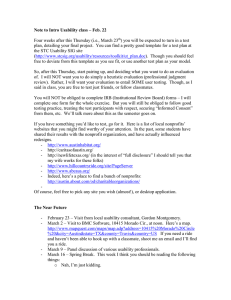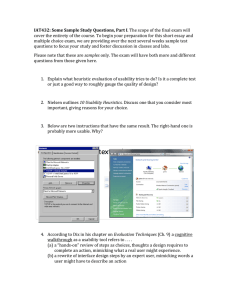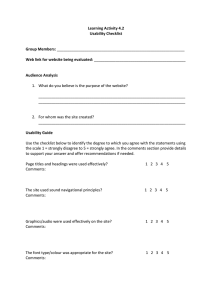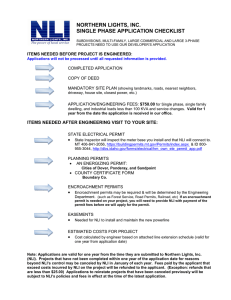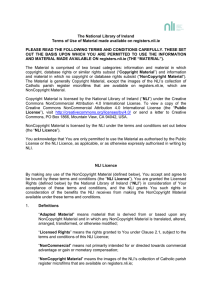Final Project Ideas
advertisement
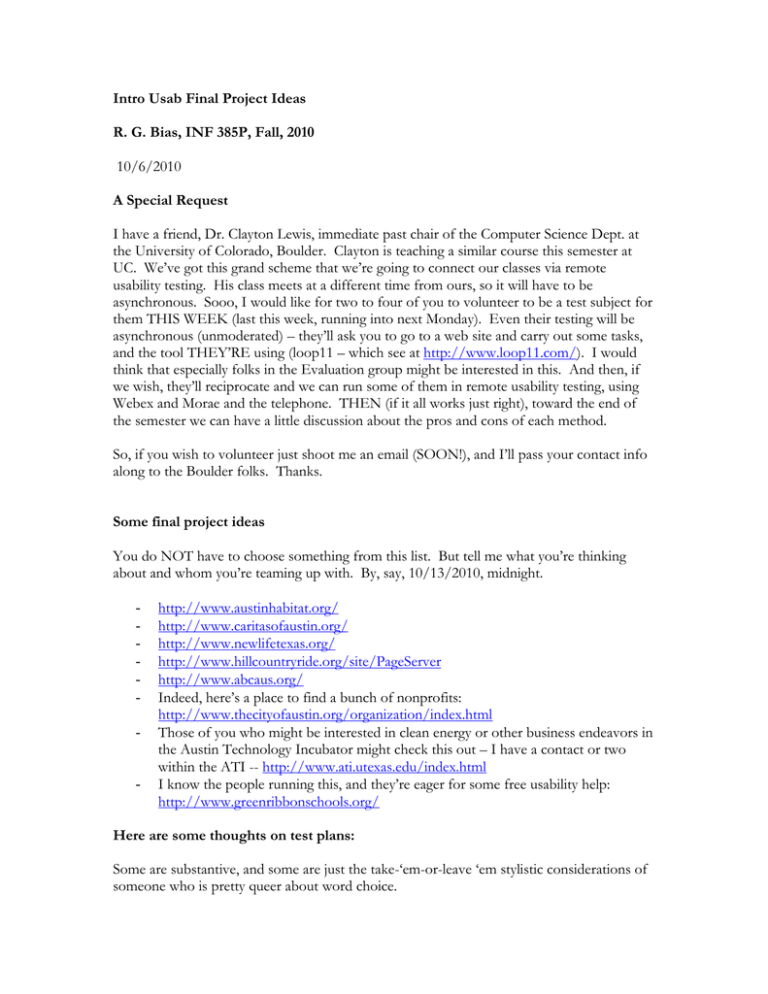
Intro Usab Final Project Ideas R. G. Bias, INF 385P, Fall, 2010 10/6/2010 A Special Request I have a friend, Dr. Clayton Lewis, immediate past chair of the Computer Science Dept. at the University of Colorado, Boulder. Clayton is teaching a similar course this semester at UC. We’ve got this grand scheme that we’re going to connect our classes via remote usability testing. His class meets at a different time from ours, so it will have to be asynchronous. Sooo, I would like for two to four of you to volunteer to be a test subject for them THIS WEEK (last this week, running into next Monday). Even their testing will be asynchronous (unmoderated) – they’ll ask you to go to a web site and carry out some tasks, and the tool THEY’RE using (loop11 – which see at http://www.loop11.com/). I would think that especially folks in the Evaluation group might be interested in this. And then, if we wish, they’ll reciprocate and we can run some of them in remote usability testing, using Webex and Morae and the telephone. THEN (if it all works just right), toward the end of the semester we can have a little discussion about the pros and cons of each method. So, if you wish to volunteer just shoot me an email (SOON!), and I’ll pass your contact info along to the Boulder folks. Thanks. Some final project ideas You do NOT have to choose something from this list. But tell me what you’re thinking about and whom you’re teaming up with. By, say, 10/13/2010, midnight. - - http://www.austinhabitat.org/ http://www.caritasofaustin.org/ http://www.newlifetexas.org/ http://www.hillcountryride.org/site/PageServer http://www.abcaus.org/ Indeed, here’s a place to find a bunch of nonprofits: http://www.thecityofaustin.org/organization/index.html Those of you who might be interested in clean energy or other business endeavors in the Austin Technology Incubator might check this out – I have a contact or two within the ATI -- http://www.ati.utexas.edu/index.html I know the people running this, and they’re eager for some free usability help: http://www.greenribbonschools.org/ Here are some thoughts on test plans: Some are substantive, and some are just the take-‘em-or-leave ‘em stylistic considerations of someone who is pretty queer about word choice. - - - - - - - - Reminder – I’m doing a blanket IRB form for our whole class. If you wish to subsequently publish your results (unlikely, if you’re testing a convenience sample), you’ll have to complete a separate, individual IRB form, retroactively. It is a good thing to describe in your test plan (and, again later in your report) HOW you chose your particular tasks to test. If you just picked ‘em out of the air, using your own common-sense understanding of the site, that’s fine. Just say so. Note, when you write your test REPORT, you’ll likely start with your test plan, and just turn all the verbs into past tense. Then add the results and discussion. It’s not quite that simple, but close. One concern is WHERE to start the test participants. Do you take ‘em to the home page of the site being tested? Or is one of your goals to see if they look for that site, and can find it if they do? If the latter, I think it is a fine idea to START the test by NOT mentioning the site in question, but by asking a more general question. Here’s an example. Say you were testing the New Life Institute site. This Institute provides low- or no-cost mental health counseling. It would make sense to say, as the first task, “OK, you have a friend in Austin who needs some psychotherapy, but he doesn’t have much money, nor mental health insurance. You decide to go online to see if you might find someplace for him to go for some help. Show me what you’d do.” Then you see a) if they know about New Life Institute and go looking for it, b) if they perform a more general search, and if so what terms they use, and c) if they find the NLI site, in any case. THEN after that task (whether they were “successful” or not), task 2 might be something like, “Someone has told you there’s this group in town called New Life Institute. Here’s their home page. Go find what their fees are.” (Or whatever.) Of course, take care not to mention NLI in the Informed Consent form, or other pre-test materials. (Indeed, you MIGHT avoid saying “the website” as it will imply to the test participants that there is ONE site you’re testing.) I think this may be an artifact of the test plan templates some students have used in the past, but give some thought to what measures you actually intend to employ. Are you REALLY going to count “nonverbal expressions of frustration”? If yes, fine. But I often see students listing a whole bunch of measures they intend to collect, and then in the test report they list just time on task, error rates, and particular errors. As with the tasks, say how you arrived at “measureable usability criteria.” Why have you decided to declare “failure” if people can’t complete the task in five minutes? Because the stakeholders say that’s their nickel? Because you observed yourself carrying out the task the first time, on this and on a competitor site, and that seemed about right? Whatever. Just say so. A student once asked me, do we tell the test participant that one of the observers is a stakeholder in the site being tested (perhaps even one of the designers), or do we hide that from them? I don’t think we hide it. Indeed, I think the right answer might be to say “we” are involved in the design (so that it doesn’t differentially influence the results when one of you is interacting with the test participants), but to make it clear that you are interested in making the site better, and thus in their candid responses. OK, some writing nits: o et al. is written just as such – no period after the et, yes period after the al. Et is a whole word, meaning “and.” Al. is an abbreviation for “alia,” “others.” o I’m the last person in the world who still cares about this, but “their” is a plural pronoun. People use it to avoid sexist pronouns. But they use it incorrectly – “The user . . . their opinion . . . .” The best way to avoid sexist pronouns is to go plural, when you can – “The users . . . their opinions . . . .” A relatively poor way is to go passive voice – “The opinion of the user . . . .” I’m fine with “his/her” or “he or she,” though I know lots of people find this awkward. o When you use a bullet list, make sure each item has parallel sentence structure (e.g., starts with the same part of speech) and completes the sentence appropriately. I often see things like the following Our goals were to see if users could: Correctly navigate the site. Liked the site. Good aesthetics. That makes my teeth hurt. o I realize even Time magazine has gone away from the “serial comma” (the comma after the penultimate noun in a series of three or more), but I think it helps disambiguate sentences. Plus if it’s good enough for Strunk and White (and on page 2!!– “Thus write ‘red, white, and blue.’”), it’s good enough for me. “Templates? Did you say templates?” Check out the file “ut_plan.doc” http://www.stcsig.org/usability/resources/toolkit/toolkit.html. Here’s a thin one: http://www.lib.washington.edu/Usability/testplan.html Here’s an actual plan I found online: http://www.faculty.english.ttu.edu/5388/Resources/Blurr%20Test%20Plan.pdf Hmm. See if this is anything: http://www.htmlcenter.com/blog/usability-testing-for-yourweb-site/ The point is, there’s no one right way. Offer enough detail so that someone else could replicate your study, and the stakeholders can tell what you’re going to do. The test plan is an excellent team communications vehicle. It gives the developers (or marketers, or sales team, or management) a chance to say, “Oh, no, don’t test that task. We really need you to look at this task.” Then you negotiate. THEN, once you present your results, teams can’t say “Oh, we didn’t know you were going to test THAT. THAT is not even in the product plan anymore.” Or some such.

